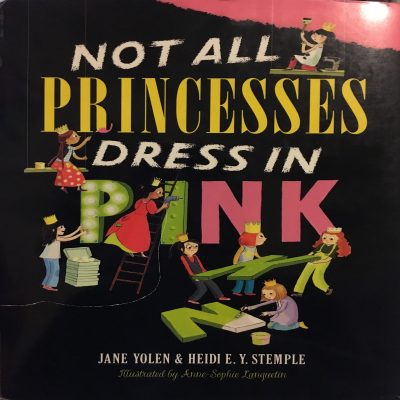- Title: Not All Princesses Dress in Pink
- Author(s): Jane Yolen, Heidi E. Y. Stemple
- Illustrator/Photographer: Anne-Sophie Lanquetin
- Publisher and Year: Simon and Schuster Books for Young Readers, 2010
- Number of Pages: 29
- Genre: Fiction
- Analysis: Not All Princesses Dress in Pink explains the different types of princesses there are, and how it is possible to still do “unprincess-like” things, while still wearing a “sparkly crown.” These princesses are not afraid to get dirty and have fun, but that does not alter the fact that they can still be princesses. This book teaches young children that gender roles and stereotypical images of princesses should not apply to all girls.
I believe that Not All Princesses Dress in Pink can be used as a mirror for girls who feel as though their love for “nongirly” things are not the norm, when in fact, it is perfectly normal. Girls need to see themselves represented in books that are not overloaded with the color pink, or books that do not say all girls need to be clean and ladylike. It is possible to still be a princess and roll around in the mud or play sports. Girls are children too, so their fun should not be limited to Barbie dolls and shoe-shopping. While dismissing the stereotype of girly girls, Not All Princesses Dress in Pink also touches on gender norms. “Some princesses wear their jewels while fixing things with power tools (13),” is a great example of deconstructing the myth that only men can do physical labor; it is important for young girls to see this message and understand that they are just as powerful as any boy.
The front cover of the book shows girls wearing their princess crowns, which changes the initial cover. Most of the page is black, except for the top right corner, which is pink. A young girl is portrayed painting over the pink background, depicting the fact that not all girls like pink. Another aspect shows young girls do construction work and designing the cover how they see fit, once again, changing any pink that was initially there. The cover sets the tone for the whole book, because throughout the story we see these themes of girls living their lives the way they want to, rather than through society’s standards. In a typical book about princesses, you see plenty of pink and dresses, however, the illustrator shows girls with dirt stains, paint-covered clothes, overalls, and any other form of regular clothing. This helps to articulate the fact that girls can be normal, just like boys. I think that Not All Princesses Dress in Pink does a great job in showing young girls that it is okay to be different. It also shows that the oversaturation of femininity is not that common, and that there are other girls who behave just like them.


